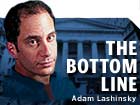
SAN FRANCISCO (CNN/Money) -
Writers love readers who are writers. In fact, the mail has been flooding in lately. Many folks have such interesting things to say -- and pressing questions -- that I can't resist printing a few letters. For the record, I'll never give individual investment advice. But often times the question one asks can be useful to all.
Most correspondents liked Monday's piece advocating splitting research from investment banking at Merrill Lynch and others. These didn't include a pal of mine, an economist and libertarian, though not necessarily in that order. "You've got to be kidding me. You favor having the government decide that bundling research and underwriting is too dangerous for the ignorant individual investor? Whatever happened to caveat emptor? What if the government decided that there was too much opinion and too little news in Fortune/CNN productions and decided to split off advertisements from articles?"
My friend signed his letter, "appalled," which is a good man-in-the-street thing to be. And he makes a good point. I don't really care how research and banking are split, whether it's through government intervention to stop fraudulent behavior or through industry self-interest, a position Holman Jenkins advocated Wednesday in The Wall Street Journal. (By the way, bad choice in comparing brokerages to publications. The former is heavily regulated, while the latter enjoys Constitutional protection under the First Amendment.)
Another investment pro, Jack D. Meyercord, argues that "if all research goes private, the little guy gets left out because he cannot afford it. Then you'll be writing articles about how Wall Street is keeping the individual investors out to maintain an unfair information advantage in the market place."
Jack, you've put your finger on an important issue here. In my opinion, the "little guy" never should have been acting on the advice of an analyst whose research he didn't buy in the first place. Under the system that prevailed before fixed rate commissions were abolished in the 1970's, however, investors could get access to reasonably priced research – through their brokers. I'm not against having analysts work for brokers. I'm against them working for bankers.
Naveed Yahya, who's in the fund business in Rochester, NY, was kinder to me. "All the major brokers have asset management divisions that could easily employ these analysts, while also making their research available to the public," he writes. "If brokers for individuals want to provide their clients with research, let the clients purchase it and then it is up to the brokers how they charge their clients for it (if at all)."
I mostly agree with Yahya. Asset-management firms, often within the same investment banks, certainly could employ the sell-side analysts. But the current crop of media stars typically makes far more money than less heralded buy-side analysts in no small part because they're paid to hype stocks. Force them to exist solely on the merit of their information and there'd undoubtedly be fewer of them, making less money.
Stock-split math
Plenty of bits and bytes were spilled over my screed about AT&T's proposed reverse split. Importantly, John Howard wanted to know if the reverse split gives AT&T a way to lower its annual dividend, currently 15 cents. An AT&T spokeswoman replied with an emphatic no.
| |
 RECENTLY BY ADAM LASHINSKY
RECENTLY BY ADAM LASHINSKY
| |
| | |
| | |
|
Although she noted that it's impossible to promise the dividend won't be lowered, AT&T's past history with spin-offs suggests Ma Bell won't alter the dividend yield with the reverse split. In other words, if the share count goes down by 80 percent and AT&T share price goes up fivefold, the dividend also will rise fivefold, to 75 cents. Investors would have a higher per-share dividend but fewer shares, amounting to the same payout. Another way of thinking about this is that the total amount of cash AT&T uses to pay the dividend won't change, that is, unless AT&T decides to lower the dividend, which it hasn't said it will do.
Similarly, "Jay in Scottsdale" suggests that "it will be a cold day in hell if the board equally adjusts strike prices on employee option packages UP fivefold." Actually, Jay, according to the special proxy AT&T has filed, the company plans to do just that. "The conversion ratios of AT&T's outstanding stock options and securities having a conversion or redemption feature will be correspondingly adjusted upon the consummation of any reverse stock split," the proxy reads. But don't take my word for it. AT&T has provided a frequently asked questions page, which will lead you to the proxy, all 716 pages of it.
Adam Lashinsky is a senior writer for Fortune magazine. Send e-mail to Adam at adam_lashinsky@timeinc.com.
Sign up to receive The Bottom Line by e-mail.

|

